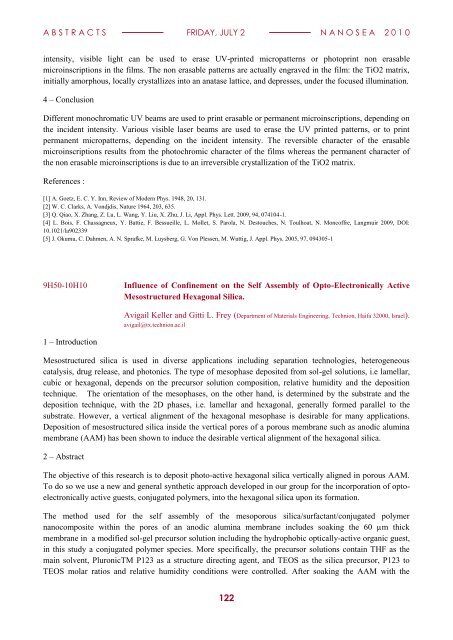book of abstracts - IM2NP
book of abstracts - IM2NP
book of abstracts - IM2NP
Create successful ePaper yourself
Turn your PDF publications into a flip-book with our unique Google optimized e-Paper software.
A B S T R A C T S FRIDAY, JULY 2 N A N O S E A 2 0 1 0<br />
intensity, visible light can be used to erase UV-printed micropatterns or photoprint non erasable<br />
microinscriptions in the films. The non erasable patterns are actually engraved in the film: the TiO2 matrix,<br />
initially amorphous, locally crystallizes into an anatase lattice, and depresses, under the focused illumination.<br />
4 – Conclusion<br />
Different monochromatic UV beams are used to print erasable or permanent microinscriptions, depending on<br />
the incident intensity. Various visible laser beams are used to erase the UV printed patterns, or to print<br />
permanent micropatterns, depending on the incident intensity. The reversible character <strong>of</strong> the erasable<br />
microinscriptions results from the photochromic character <strong>of</strong> the films whereas the permanent character <strong>of</strong><br />
the non erasable microinscriptions is due to an irreversible crystallization <strong>of</strong> the TiO2 matrix.<br />
References :<br />
[1] A. Goetz, E. C. Y. Inn, Review <strong>of</strong> Modern Phys. 1948, 20, 131.<br />
[2] W. C. Clarks, A. Vondjdis, Nature 1964, 203, 635.<br />
[3] Q. Qiao, X. Zhang, Z. Lu, L. Wang, Y. Liu, X. Zhu, J. Li, Appl. Phys. Lett. 2009, 94, 074104-1.<br />
[4] L. Bois, F. Chassagneux, Y. Battie, F. Bessueille, L. Mollet, S. Parola, N. Destouches, N. Toulhoat, N. Monc<strong>of</strong>fre, Langmuir 2009, DOI:<br />
10.1021/la902339<br />
[5] J. Okumu, C. Dahmen, A. N. Sprafke, M. Luysberg, G. Von Plessen, M. Wuttig, J. Appl. Phys. 2005, 97, 094305-1<br />
9H50-10H10<br />
Influence <strong>of</strong> Confinement on the Self Assembly <strong>of</strong> Opto-Electronically Active<br />
Mesostructured Hexagonal Silica.<br />
Avigail Keller and Gitti L. Frey (Department <strong>of</strong> Materials Engineering, Technion, Haifa 32000, Israel).<br />
avigail@tx.technion.ac.il<br />
1 – Introduction<br />
Mesostructured silica is used in diverse applications including separation technologies, heterogeneous<br />
catalysis, drug release, and photonics. The type <strong>of</strong> mesophase deposited from sol-gel solutions, i.e lamellar,<br />
cubic or hexagonal, depends on the precursor solution composition, relative humidity and the deposition<br />
technique. The orientation <strong>of</strong> the mesophases, on the other hand, is determined by the substrate and the<br />
deposition technique, with the 2D phases, i.e. lamellar and hexagonal, generally formed parallel to the<br />
substrate. However, a vertical alignment <strong>of</strong> the hexagonal mesophase is desirable for many applications.<br />
Deposition <strong>of</strong> mesostructured silica inside the vertical pores <strong>of</strong> a porous membrane such as anodic alumina<br />
membrane (AAM) has been shown to induce the desirable vertical alignment <strong>of</strong> the hexagonal silica.<br />
2 – Abstract<br />
The objective <strong>of</strong> this research is to deposit photo-active hexagonal silica vertically aligned in porous AAM.<br />
To do so we use a new and general synthetic approach developed in our group for the incorporation <strong>of</strong> optoelectronically<br />
active guests, conjugated polymers, into the hexagonal silica upon its formation.<br />
The method used for the self assembly <strong>of</strong> the mesoporous silica/surfactant/conjugated polymer<br />
nanocomposite within the pores <strong>of</strong> an anodic alumina membrane includes soaking the 60 µm thick<br />
membrane in a modified sol-gel precursor solution including the hydrophobic optically-active organic guest,<br />
in this study a conjugated polymer species. More specifically, the precursor solutions contain THF as the<br />
main solvent, PluronicTM P123 as a structure directing agent, and TEOS as the silica precursor, P123 to<br />
TEOS molar ratios and relative humidity conditions were controlled. After soaking the AAM with the<br />
122

















